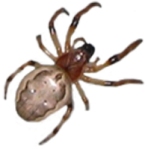MN Pest Control- Spiders
Spiders are a common group of arthropods. They are similar to insects in that they both have exoskeletons and jointed legs. However, spiders differ from insects in several ways. Any arthropods that share the same characteristics as spiders are known as arachnids. Other arachnids, or spider relatives, include ticks, daddy-longlegs, scorpions, and mites.
Another difference between spiders and insects is that all spiders can produce silk throughout their lifetime. However, just a few insects can produce silk, and then at only certain times during their life. Spiders use silk to build webs and other types of snares, egg cases, draglines, and refuges. Silk is also produced by spiderlings (young spiders) during a process called ballooning in which the spiderlings shoot silk into the air and are carried away by the wind.
Spiders are predators, feeding mainly on insects. Spiders are considered beneficial because of the large number of insects they prey on, including a number of pest species. All spiders have venom and are therefore venomous. However, most spiders are harmless to people. They are very shy and usually remain hidden in undisturbed areas. Many are active only at night. They are not aggressive and they will try to escape when confronted. Few spiders bite, even when coaxed. Fortunately, the bites of most spiders are less painful than an average bee sting.
Control Of Spiders In and Around Homes
Spiders are common in homes during warm weather, although they can be found indoors any time during the year. Their numbers usually peak during late summer and fall, when they are sometimes found indoors searching for winter hibernation sites.
Spider control is usually challenging. It is difficult to eradicate all spiders from a home. It is also unnecessary. Properties located in areas favorable to spiders, such as by rivers, lakes, or fields, are more likely to have large numbers of spiders.
Tolerate spiders whenever possible. Because of their beneficial nature, they are very important to the environment. When tolerance is not possible, use an integrated approach using nonchemical methods supplemented with chemical means to reduce spider numbers.
Outdoor Control
If it is necessary to reduce the number of spiders in and around your home, start with nonchemical methods including sanitation to prevent spiders from entering from the outside.
- Remove piles of bricks, firewood, and other debris that may serve as suitable homes for spiders or move them further from your home.
- Keep grassy or weedy areas near buildings cut short.
- Trim back shrubs and other plants that directly contact your home.
- Knock webs down with a broom or a hard spray of water.
- Remove and destroy any egg sacs or spiders that are found.
- Caulk or seal obvious cracks or spaces around the foundation, doors, and ground level windows.
- Check to be sure screens fit tightly. Replace any screens that fit poorly or are damaged.
- Change outside lights to reduce insect prey that can encourage spiders. Yellow lights are less attractive to insects than mercury or sodium vapor lights.
Indoor Control
Regular housecleaning is very important in the control of spiders indoors. Large, persistent spider populations indoors indicate the presence of a significant insect population that serves as their food.
- Remove papers, boxes, bags, and other clutter to minimize favorable sites for spiders.
- Remove webbing with a broom or vacuum, and destroy any egg sacs and spiders that are found. Look especially around windows, in corners and other relatively quiet places.
- Eliminate insects that serve as a food supply, especially when large numbers exist. Check particularly in and under webs to see what insects have been captured.
You can supplement your sanitation efforts with an insecticide treatment. Treat especially behind base-boards, in cracks and crevices, and other places where spiders may hide. General treatments on surfaces and fogs are not effective. Most insecticides labeled for ants and cockroaches are also labeled for spiders. These products are commonly found in aerosol ready-to-use cans.
CAUTION: Read all label directions carefully before buying insecticides and again before using them. The label is the final authority on how you may legally use any pesticide.
Common Spiders in and Around Your Home
|
Jumping Spiders

|
They are active during the day and are often found around windows, ceilings, walls, and other areas exposed to sunlight. Jumping spiders are generally small to medium-sized (about 1/5 – 1/2 inch long) and compact-looking. They are usually dark-colored with white markings, although some can be brightly colored, including some with iridescent mouthparts. These spiders move quickly in a jerky, irregular gait. They get their name from their ability to leap on their prey, often jumping many times their own body length. Like most spiders, jumping spiders have eight eyes, of which the two middle eyes are particularly large. Jumping spiders have the best vision of spiders, seeing objects up to 8 inches away. |
Wolf Spiders |
They are moderate to large-sized spiders (1/4 – 3/4 inch long). Wolf spiders are found on the ground or under stones in a wide variety of habitats, such as forest floors, grassy meadows, swamps, and bogs. Some even like to live underground. They commonly hunt during the day or at night when it is warm. Wolf spiders are dark-colored, usually brownish or grayish, with white markings. |
Fishing Spiders |
These are also known as dock spiders, are typically seen around ponds, swamps, slow-moving streams, and nearby vegetation. They may occasionally be found indoors. Fishing spiders are the largest spiders in the Upper Midwest (1 inch long). With legs spread out, some fishing spiders cover as much as 4 inches. They are generally dark-colored, usually brownish or grayish, with white markings. Fishing spiders can “skate” across water and can dive underneath to capture prey. In addition to insects, fishing spiders can also catch tadpoles, small fish, and other small vertebrate animals. |
Crab Spiders |
These are common spiders outdoors, but are not usually seen indoors. They are small to medium-sized spiders (1/10 – 2/5 inch long) ranging in color from yellow or red to brown or gray. The first four legs of crab spiders are crab-like, being held out to the sides. They are also usually longer than the back four. Crab spiders can walk forwards, sideways, or backwards. While many hunting spiders actively pursue prey, crab spiders wait motionless and ambush insects that pass closely by. Outdoors, crab spiders are often found on flowers but are also seen on stems or leaves. |
Gnaphosid Spiders |
A specific Gnaphosid spider known as a parson spider (figure 6) is occasionally seen inside. The parson spider is a medium-sized spider (1/2 inch long) with a brownish body and gray abdomen with a white band running down over half the length of its abdomen. Parson spiders hunt at night. During the day, they are usually found outdoors under stones or loose bark in silken retreats. Indoors, they hide under objects or in cracks or crevices. |
Comb-Building Spiders |
These are also known as cobweb spiders, are very common spiders outdoors and indoors. They are small to medium-sized spiders (about 1/8 – 3/8 inch long). Comb-footed spiders are usually brownish or grayish. They build irregular webs in many places, including wood and stone piles and in quiet areas of buildings, such as basements. A common type of comb-footed spider found indoors is the house spider (figure 7). It is grayish to brownish with chevron-like markings on its abdomen and a body length of over 1/4 inch. |
Orb Spiders |
These are common spiders outdoors near buildings, but are usually not found indoors. They range in size from small to large (1/8 – 1 inch long) and are found in a variety of colors, with some being brightly colored. Orb spiders have large, swollen-looking abdomens, including some that are oddly shaped. They make the classic round, flat, wheel-like web familiar to most people.The black and yellow argiope (are-JI-o-pee) spider (figure 8), also known as the garden spider, is familiar to many. It is large (up to 1 inch long) and brightly colored black and yellow. Another common orb spider is the barn spider (figure 9). It is large (4/5 inch long) and brownish in color. |
Grass Spiders |
A type of funnel weaver, are common outdoors and are occasionally found indoors. They are generally brownish or grayish with light and dark stripes near the head. They have long spinnerets and are moderate-sized (3/4 inch long). Grass spiders construct a large sheet web with a funnel they use as a retreat. These webs are commonly built on the ground, around steps, window wells, foundations, and low shrubs. |











